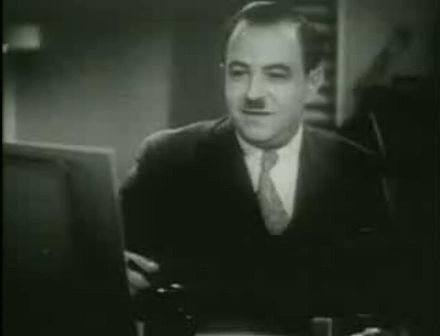
Later famous for Betty Boop and Popeye, Max Fleischer had a different approach to animation compared to the likes of Walt Disney or even Winsor McCay, in that his technique tended to be less refined and more jerky, and his cartoons were not merely to entertain but often tackled adult issues and were on the whole darker and more mature than anything that was around at the time, or would be for some considerable time. His perhaps most famous early animation, preceding Disney's by two full years, was
My Old Kentucky Home, released in 1926 and featuring a cartoon dog blowing a trumpet and encouraging the viewer to sing the words to the old nineteenth-century song. Although crude, even by the standards Disney would set down from the off (cruder even than Oswald or, in some ways, Felix) , this animation was important as it was the first to successfully synchronise audio to the animation, so that when the dog says”Follow the bouncing ball and join in everyone,” you can follow the shape of his mouth as the words are spoken.
Fleischer had pioneered the concept of “follow the bouncing ball” which would become a staple in animation, jumping in time with the music from word to word in a prehistoric version of
karaoke. Of course, as an animation this one is boring (although I can only get an excerpt from it, and don't know if there was more than there is here, a mere fifty seconds) but it did establish an important precedent.

Paul Terry (who would go on to produce Terrytoons, one of the most less successful cartoon studios of the twentieth century, even though it did produce memorable characters such as Heckle and Jeckle, Mighty Mouse and Deputy Dawg) also brought an animation with sound to the screen a mere month before Disney stole the limelight with their cartoon. Terry's was called
Dinner Time and featured what looks to be a crow (some sort of bird anyway) seeking his dinner. After unsuccessfully trying to catch a worm, he is then almost eaten by a cat as he stands on telephone wires and the cat leans out of the window of a building, trying to reel him in. Eventually the cat does catch him, but the bird flies off, taking the cat with him. The cat lets go, and clings on to the wires, but the bird returns and cuts them with his beak. As the cat falls we see ghostly images of each of his nine lives leaving him. He hits the ground, then climbs back up the nine lives, using them as stairs, to get back in the window from which he fell out.
Next we follow the adventures of a small dog, who stops at a lake and with a bone in his mouth sees his reflection holding a bone. In the improbable logic of the world of cartoons, the dog jumps into the lake, takes the reflection's bone and now has two! And so it goes on. You can see in the crude drawings the ancestors of later Popeye, and the paper used is curiously yellow, though that could be age. Still, none of the other, older cartoons looked faded. Anyway, the clip here will give you an idea, but I have to say, I don't see anything in the way of sound synchronisation, other than sound effects and the odd voice. Perhaps unsurprisingly, the cartoon did not endear itself to audiences, and a month later everything changed, forever.